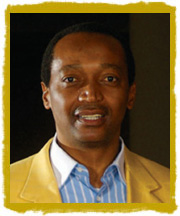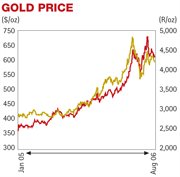![]() Letter from the Chairman (PDF -
280KB)
Letter from the Chairman (PDF -
280KB)
In my letter to shareholders last year, I proudly proclaimed myself a gold bug. Given the events of the past year, this remains true and the band of converts has grown considerably.
The gold market
This has been a good year for the gold market – in fact, I would call it a great year. Some gold analysts are saying that this is the best gold market that we have seen in the past 20 to 30 years.
There are several fundamental reasons for gold’s strength. On the one hand, in times of strife and uncertainty, be this political or economic, comfort is to be found in gold as a safe haven. The recent upheavals in the Middle East and the rising oil price have spurred increases in the gold price. This has all been positive for demand. Additionally, the surge in economic growth globally has resulted in solid demand for gold jewellery.
On the other hand, the increasing consolidation of the gold industry by the majors has been more about maintaining production by grouping together operations where there are perceived to be synergies than finding new ounces and thus has not resulted in more gold being produced. At the same time, juniors have not been able to discover or turn to account any significant discoveries. These factors have together resulted in a gold market that is constrained on the supply-side for the first time in many years
Harmony has benefited from and has also been challenged by the global trend.
The rising price in US dollar and rand terms has boosted Harmony’s earnings during the past year. The average dollar gold price in the 2006 financial year was US$529/oz, 24% higher than the US$427/oz of the previous year. But it is the rand gold price that at last benefited South African producers, particularly towards the end of the current financial year. While the average rand:dollar exchange rate was R6.36/US$1 compared with R6.18/US$1 the previous year, by financial year end it had reached a level of R7.17/US$1. This meant that the average rand gold price received rose by 28% year-on-year to R108 268/kg – currently this stands at approximately R140 000/kg.
Fundamentally it is Harmony’s gearing to price rises and our ability to grow that has attracted investors to the company over the past 10 years, and that rationale remains true today.
Financial performance
Although Harmony recorded a net loss in FY06 of R525 million (US$86 million), this was a considerable improvement on the results recorded in FY05 when the net loss was R3 214 million (US$521 million). We are encouraged by our performance in the fourth quarter of the financial year when our cash operating profit more than doubled quarter on quarter from R305.6 million to R645 million (US$50 million to US$100 million). While we must acknowledge that this improved financial performance had much to do with the gold price received, it is important to note that cost savings also made a significant contribution. Based on a year-on-year comparison, cash operating profit rose from R869 million to R1 459 million (US$141 million to US$229 million).
As outlined in more detail below and elsewhere in this report, we have done much to streamline our mining activities – from improving flexibility by stepping up development rates to focused productivity initiatives. We anticipate production to increase to between 2.6Moz and 2.8Moz in the next financial year.
Operating performance
Harmony has grown over the past 10 years, from a single lease bound operation, producing some 650 000oz of gold per annum, into a multi-million ounce producer with one of the largest resource bases, and a life of mine in excess of 20 years.
Over the past eight years, Harmony acquired in excess of 20 companies and shafts in an attempt to achieve critical mass and unlock value. During this time the company built up a diverse portfolio, including some of the most leveraged, yet marginal mines in the world. However, along with the opportunities provided by these assets came the reality that, within the packages acquired, were mines or shafts at the end of their economic lives, excess infrastructure and services, massive land portfolios and onerous environmental liabilities. We also inherited an ever greater worker complement in a labour system that does not easily allow for downsizing. The coincidence of a relatively strong South African rand and a gold price, that had been in the doldrums for a prolonged period, left us no alternative but to restructure the company to ensure optimum profitability. The restructuring took longer than the company would have liked, and certainly longer than was planned. At the operating level, the company is only now starting to see the benefit of the massive restructuring exercise that began over two years ago.
The ship has now turned and while it is not yet steaming ahead at full throttle into open waters, there are plans to revitalise Harmony’s growth strategy. In spite of the difficult and challenging conditions encountered at an operating level in the past year, the board remains committed to Harmony’s local and international growth programmes. Expansionary and operational capital expenditure of some R1.7 billion (US$266 million) was spent during the past year. Our unique project pipeline in South Africa and in Papua New Guinea will deliver not only growth, but an asset base whose quality will be enhanced over time as recovery grades from underground ore improve.
Prospects
Given the vagaries and the volatility of the markets, it is a brave man who dares to forecast the gold price. We do believe, however, that the gold market is likely to remain buoyant, that global production will continue to diminish, that new production will come on stream at both a greater cost and an increased risk as miners venture into formerly unchartered territories, and that the rand is unlikely to recover recent lost ground.
Harmony is committed to pursuing the rand per tonne cost control philosophy on which this company’s reputation is built. This objective, combined with its growth ambitions, set the company on a course to return production to the 3.5Moz level by 2010, when about 50% of our production will come from new projects.
Thanks
I would like to thank the board members who stood down during the year: Ferdi Dippenaar, who left the company to pursue personal business interests; Ted Grobicki, who retired from the industry after a long and distinguished career; Nolitha Fakude, whose appointment as an executive director at Sasol has limited her time for external responsibilities; and Rick Menell, who is now focusing on an exploration company listed on the Toronto Stock Exchange. I extend a warm welcome to Fikile De Buck who has joined our board and look forward to her fruitful association with the company. I would also like to express my sincere appreciation to my current board members, to the management of Harmony and to the company’s more than 40 000 employees around the globe, for their commitment and dedication throughout the year. Together, we look forward to a challenging and more rewarding year ahead.
Patrice Motsepe
Non-executive chairman
13 September 2006








